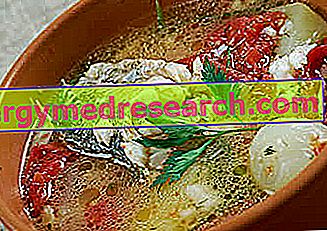Generality
Fish broth is a recipe that belongs to the "kitchen bases".
It has a liquid consistency, beige or straw color and clear transparency. On the palate it is tasty and very aromatic.

Despite the apparent similarity, the fish broth is fundamentally different from the fish stock (see below) and even more compared to the Bisque and the Brodetto.
The main ingredients are:
- Water.
- Fishery products or parts thereof.
- Vegetables.
- Condiments.
Like meat broth, even fish broth must be filtered to eliminate any solid component.
Being a "cooking background", the fish broth is mainly used to prepare various recipes, more or less complex; nothing detracts from that it can also be consumed alone (consommé).
Nutritional Features
Fish broth is a product that cannot be classified among the seven fundamental food groups.
More like a drink, it has almost no nutritional impact.
It mainly supplies water, useful to guarantee the state of body hydration.
It also contains a small concentration of:
- Mineral salts: phosphorus, potassium, sodium, etc.
- Iodine, normally abundant in sea fishing products, is not very significant in this case.
- Vitamins: scarce; they are predominantly from the B group and carotenoids.
- Peptides or free amino acids, many of which are sulfur.
- Collagen is also present (mainly found in cartilaginous fish such as the breed and torpedo), rich in glycine and proline amino acids.
- Fatty acids: they are almost irrelevant, even if of good quality (many omega 3).
Cholesterol and fiber are not conspicuous.
Fish broth is suitable for most diets, including those for metabolic diseases and overweight. In the latter case it is even suggested, by virtue of its satiating capacity and the absence of calories.
On the other hand, considerable portions of fish broth are contraindicated for those suffering from gastric pathologies (gastritis, ulcer), hiatal hernia and inferior esophageal sphincter incontinence, reflux disease (GERD), hypochloridria and other digestive difficulties.
It is not recommended even close to physical activity or sports sessions.
It is useful in the diet against constipation thanks to the abundance of water.
Collagen in fish broth is considered useful for preserving joint cartilages, tendons and ligaments; on the other hand, adequate scientific confirmation is lacking to support this hypothesis.
It is not permitted by the latto-ovo vegetarian and vegan philosophies.
The average portion corresponds to about 300 ml.
Simple recipe
Instruments
Knife, potato peeler, cutting board, muffler or casserole (alternatively pressure cooker *), Chinese strainer (chinoise), stove.
Ingredients
Water 4-6 liters, garlic 1 clove, black pepper 3-4 grains, coarse salt 1-2 tablespoons (if necessary), a bay leaf, celery 100 g, carrots 100 g, white or yellow onion 100 g, fresh parsley QB, bones and / or heads and / or fish cuttings * QB, shellfish carapace, QB, filtered cooking water of bivalve QB molluscs.
* Avoid blue fish.
Method
- Fill the muffler with cold water.
- Wash, peel and cut the celery, carrots and onion into pieces.
- Prepare scraps of fishery products.
- Dip all the ingredients in the water (keep the salt at the end).
- Put the pan on the stove over medium heat. Let it simmer (<100 ° C) for at least 2 hours; at the end, add the cooking water from the molluscs and, if necessary, add salt.
- Allow to cool in the pan.
- Strain through the Chinese strainer being careful not to let the sediment pass.
* With the use of the pressure cooker it is possible to reduce the cooking time up to 45 minutes; the result is similar but the liquid tends to become cloudy.
If the fish broth is produced with cartilaginous fish, the abundance of collagen could give the cold broth a jelly-like consistency. This feature does not affect the healthiness of the broth.
- Alternative vegetables: leek, shallot, celeriac, tomato.
- Alternative flavors: tarragon, white pepper, cloves.
- Types of pitch for bones, heads and cuttings: sea bass, gilthead, monkfish, scorpion fish, gurnard, mullet, paganello, troll, marvizzo, owl fish, grouper, corvina, bream etc.
- Types of crustaceans for the carapace: shrimp, lobster, lobster, crab, Norway lobster, spider crab etc.
- Types of bivalve molluscs from which to reuse well-filtered cooking water: mussels, clams, oysters, razor clams, cockles etc.
Gastronomic uses
Fish broth can be used to cook many recipes; for example:
- Consommé normal or with a torn egg.
- Pasta or passatelli or canederli in broth.
- Sauces: by making the broth tighten and thicken (and enriching it with other ingredients such as saffron, tomato concentrate, etc.) you can make some sauces to accompany starters and main courses.
- Pasta-based first courses: in which it can replace the cooking water (also to boil lasagna pasta sheets).
- Risottos or other risotto dishes (with barley, spelled, etc.): in this case the broth is necessary to continue cooking.
- Sauces for pasta dishes: after being bound with a little flour or cornstarch or starch or rice starch and filtered, it can be used to sauté pasta-based pasta dishes (for example ravioli with sea bass).
- Vegetable puree / potatoes with fish: blending vegetables with fish broth and adding pieces of fish (or shelled molluscs and shellfish) produces an excellent dietary first course.
Differences with the comic
Without going too far into the description of the fish comic (which you can find in a complete and exhaustive way by clicking here), below we will limit ourselves to summarizing the main differences between the two recipes:
| Fish soup | Fish stock |
Both are cooking grounds and have most of the ingredients in common; however, they both need to be foamed and filtered. However ... | |
It's a broth | It is a light background |
The ingredients are immediately boiled in cold water | The ingredients are fried in butter (or oil) |
No alcoholic beverages are added | The ingredients are blended with wine (or brandy or cognac) |
It is essential that it be clear, transparent and free from impurities or surface oil bubbles | It has a less translucent appearance and the bubbles of fat on the surface are evident |
There is no significant reduction in the total volume of liquid; at discretion. | It requires a significant decrease in the total volume of liquid; must remain ½, ¼ and up to 1/8 compared to the initial one. |



